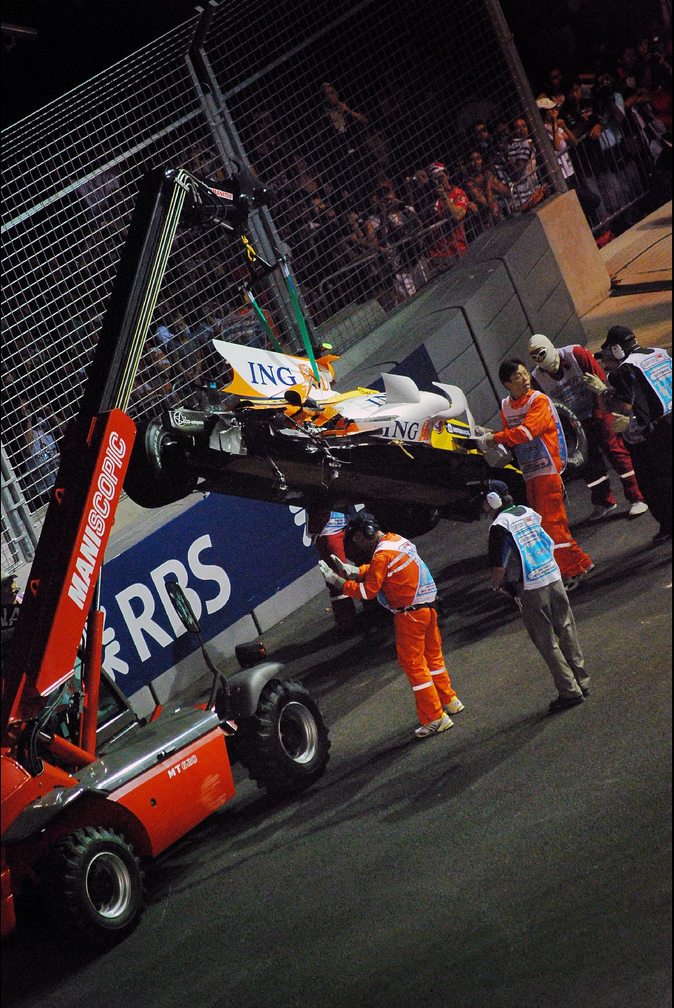"It's true, during the Sunday meeting with Piquet the issue of deliberately causing a SC deployment came up, but it was proposed by Piquet himself" P. Symonds
It's a simple matter for the FIA now of who to believe. Nelson Piquet Jr, who is accusing the Renault F1 team of colluding with him to cause a crash at the right point in the race to hand the win to Fernando Alonso. Flavio Briatore who admits a meeting took place but claims the issue was never discussed (or did last time anyone may have heard from him). Pat Symonds who claims the issue was brought up but only by the driver himself and was rejected by the team.
If Flavio is to be believed then Renault are the victims of a bitter former driver looking for payback. This seems the most logical choice initially, but then you remember than Nelson Piquet (the father of the driver in question and three time world champion) was the man who made the initial claim, not his son. Nelson is not a man to stake his reputation on a lie. Then we have the Symonds version. To believe this we must also believe that a team who new that a deliberate crash was in their drivers mind then saw him crash and thought nothing of it. The whole right rear corner of Nelsinho's car was destroyed. Not a cheap matter by any stretch of the imagination. So why was he not sacked if the team had reason to believe he had willfully destroyed one of their cars. Not only that but should it come out that Piquet had carried out his plan, say nearly a year later, the teams name would be dragged through the mud and their reputation left in tatters.

No matter what the result of the investigation into the events surrounding Fernando Alonso's surprise win at Singapore last September the implications for the sport have to be massive. This isn't just a crash changing the outcome of a race, this is a team conspiring internally to endanger the lives not only of it's own drivers but the rest of the drivers on the grid. This is a team attempting to artificially engineer a situation in which their driver would win a race with little effort.
The name of F1 has already been dragged through the mud enough over the last few years. The acrimony of Fernando Alonso's time at McLaren. The 'spygate' scandal involving McLaren (again) having a dossier on Ferrari's car in their possession. Renault being accused of the same crime involving McLaren data. Max Mosley's penchant for S&M. The threatened FOTA breakaway leading to the potential ousting of Mosley from his position at the head of the FIA, the sports governing body. The lying scandal that hit the Australian Grand Prix when McLaren's Davey Ryan and Lewis Hamilton lied to the stewards to gain a position after the race. The penalty given to Lewis Hamilton, rightly or wrongly, at Spa in 2008. Over the last few years F1 has become a laughing stock, riddled with scandal at every turn. Now, just as the sport seems finally in harmony, we are hit by what could be perceived as the worst scandal yet. Anybody who thought the worst was over should shove their head back into the sand again for a while.

The perception outside of the F1 community and it's fans is already that it's a rich mans play world. The fact that they all appear to be dishonest just goes further to disillusioning any 'floating fans' who might have felt alienated by the events they've seen unfold. The 'crashgate' saga (as it stereotypically must be called now) brings a huge amount of media attention back onto F1, this attention will for a while boost TV audiences baying for a scandal. In the long run people are going to look at F1 and think 'Why should I watch that? Their all dishonest anyway'. Personally I pray that it didn't happen, I hope that despite the evidence mounting against Renault it comes out that Nelson Piquet was just a bitter father who'd seen his son rejected and an investment of millions come to nought. F1 will survive this scandal, but it will take a long time to recover the confidence of it's audience.




